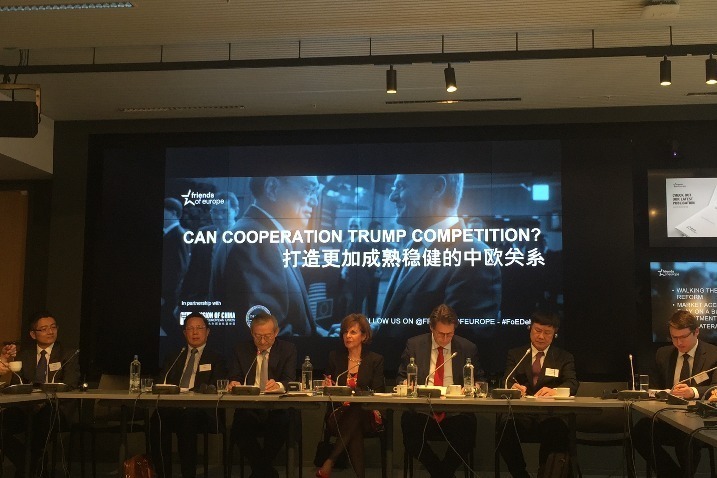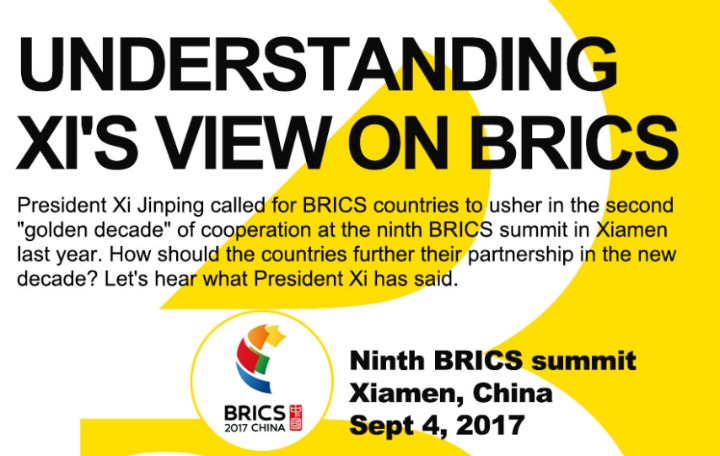Four key areas to address
By Zhao Kejin |
chinawatch.cn |
Updated: 2019-02-26 15:39
The Belt and Road Initiative(BRI), proposed by the Chinese President Xi Jinping in 2013, is China’s answer to globalization and global governance. It has been greeted with enthusiasm from 140 nations and regions and has notched up remarkable achievements. The six years since its implementation have seen greater policy connectivity, enhanced infrastructure connectivity, increased trade connectivity, expanded financial connectivity, and strengthened people-to-people connectivity.
BRI has proved to be a best practice of the Chinese endeavor to build a community of a shared future for mankind as it has provided new growth opportunities to participating nations, especially for developing countries.
It is a Chinese initiative but also a global undertaking. While it has shown some fruitful results, it has also been questioned for what is seen in some quarters as the notion’s connotation, transparency capacity building and sustainability. All these problems popping up in the implementation of the BRI cannot stymie the initiative itself but they can expose insufficient experience and inconvenient timing.
Complaints about the BRI should be a spur to better policy making and higher quality. Higher quality is not about breakneck speed or the sheer size or volume of development, but about the efficiency, the structure and sustainable development. The focus of development will shift from GDP numbers to performance like core competitiveness, capacity building, and social and ecological benefits. To realize higher-quality development, the BRI should pursue innovation, optimized structure, better governance and capacity building.
First, the BRI should be driven by innovation. Many participating nations, mired in social conflicts and squeezed by fierce competition from the developed world, without effective governance, advanced infrastructure or strong economic prowess, are bound to meet many challenges in pressing ahead with some BRI projects. Neither the market nor the government can work wonders and resolve all the foreseeable difficulties.
Therefore, innovation-driven development should be the solution. Innovation can unleash the potential of developing countries, which usually have a huge supply of inexpensive labor and land. They will have a chance to leapfrogging and slashing R&D costs if they can combine know-how, strategy, capital and markets. This innovation-driven formula has a proven track record in the Great Stone Industrial Park in the Republic of Belarus, the Thai-Chinese Industrial Zone in Rayong and the Sihanoukville Special Economic Zone in Cambodia.
Second, BRI should pursue an optimized structure. The success of this initiative hinges on the Eurasian hinterland countries. Despite abundant labor and natural resources, they have been haunted by poverty and a colonial past. Aid from the West come with lots of strings attached. The Washington Consensus and EU integration, or other West-dominated international organizations such the World Bank, usually dole out some relief packages and demand drastic political or institutional reforms. Such measures fail to do the trick or even backfire in some regions, triggering clashes.
Compared with institutional reforms, economic restructuring in those landlocked nations is a more pressing and prominent issue. Imbalances, in supply and demand, in rural and urban areas, in industrial structure, in exports and imports, have become more acute against the backdrop of globalization. That is the reason why the BRI should side with the underdog countries in promoting structural reforms. Specifically, it should work on strategic planning, resourse allocation and project design for complementary advantages and for sustainable development.
Third, the BRI should be viewed as a governance proposal, not only a development plan. Focusing merely on the development agenda and failing to tinker with the governance system will diminish the prospects of the BRI. On the one hand, the BRI involves infrastructure connectivity, international industrial capacity cooperation and cross-border cultural exchanges.
On the other, participating countries of varied cultures and often do not get along very well. It is imperative to improve governance, standards, supervision, transparency and the rule of law, and eliminate corruption and tax evasion. To make the BRI a success not a solo for China but a real chorus comprising all countries along the routes requires more channels to the public and more players on board; China can set up more programs to encourage social responsibility, public-private partnership building, people-to-people diplomacy and cultural exchanges.
Fourth, capacity building will make or break the BRI. Brilliant blueprints and grand projects will be reduced to pipedreams if there is no up-to-par people actually walking the walk and doing the heavy lifting. The path to development of higher-quality boils down to nurturing high-caliber personnel. They are expected to be well-versed in policies, business and international affairs. They can be policy makers or business leaders or experts, all of whom will serve the BRI in the frontline. Give a man a fish and you feed him for a day; teach a man to fish and you feed him for a lifetime is an old saying. The same logic can be applied to establishing human resource mechanisms and training programs to grow local talents for other countries.
The furthest distance in the world is between two cold hearts, is another old saying. It takes time for people to warm to the BRI. To promote understanding and people-to-people communication, China should step up exchanges in education, science and technology, culture, health, sports, tourism and think-tanks.
Zhao Kejin is director of the Department of International Relations, Tsinghua University.
This article was translated by Hou Sheng.
The author contributed this article to China Watch exclusively. The views expressed do not necessarily reflect those of China Watch.
All rights reserved. Copying or sharing of any content for other than personal use is prohibited without prior written permission.
The Belt and Road Initiative(BRI), proposed by the Chinese President Xi Jinping in 2013, is China’s answer to globalization and global governance. It has been greeted with enthusiasm from 140 nations and regions and has notched up remarkable achievements. The six years since its implementation have seen greater policy connectivity, enhanced infrastructure connectivity, increased trade connectivity, expanded financial connectivity, and strengthened people-to-people connectivity.
BRI has proved to be a best practice of the Chinese endeavor to build a community of a shared future for mankind as it has provided new growth opportunities to participating nations, especially for developing countries.
It is a Chinese initiative but also a global undertaking. While it has shown some fruitful results, it has also been questioned for what is seen in some quarters as the notion’s connotation, transparency capacity building and sustainability. All these problems popping up in the implementation of the BRI cannot stymie the initiative itself but they can expose insufficient experience and inconvenient timing.
Complaints about the BRI should be a spur to better policy making and higher quality. Higher quality is not about breakneck speed or the sheer size or volume of development, but about the efficiency, the structure and sustainable development. The focus of development will shift from GDP numbers to performance like core competitiveness, capacity building, and social and ecological benefits. To realize higher-quality development, the BRI should pursue innovation, optimized structure, better governance and capacity building.
First, the BRI should be driven by innovation. Many participating nations, mired in social conflicts and squeezed by fierce competition from the developed world, without effective governance, advanced infrastructure or strong economic prowess, are bound to meet many challenges in pressing ahead with some BRI projects. Neither the market nor the government can work wonders and resolve all the foreseeable difficulties.
Therefore, innovation-driven development should be the solution. Innovation can unleash the potential of developing countries, which usually have a huge supply of inexpensive labor and land. They will have a chance to leapfrogging and slashing R&D costs if they can combine know-how, strategy, capital and markets. This innovation-driven formula has a proven track record in the Great Stone Industrial Park in the Republic of Belarus, the Thai-Chinese Industrial Zone in Rayong and the Sihanoukville Special Economic Zone in Cambodia.
Second, BRI should pursue an optimized structure. The success of this initiative hinges on the Eurasian hinterland countries. Despite abundant labor and natural resources, they have been haunted by poverty and a colonial past. Aid from the West come with lots of strings attached. The Washington Consensus and EU integration, or other West-dominated international organizations such the World Bank, usually dole out some relief packages and demand drastic political or institutional reforms. Such measures fail to do the trick or even backfire in some regions, triggering clashes.
Compared with institutional reforms, economic restructuring in those landlocked nations is a more pressing and prominent issue. Imbalances, in supply and demand, in rural and urban areas, in industrial structure, in exports and imports, have become more acute against the backdrop of globalization. That is the reason why the BRI should side with the underdog countries in promoting structural reforms. Specifically, it should work on strategic planning, resourse allocation and project design for complementary advantages and for sustainable development.
Third, the BRI should be viewed as a governance proposal, not only a development plan. Focusing merely on the development agenda and failing to tinker with the governance system will diminish the prospects of the BRI. On the one hand, the BRI involves infrastructure connectivity, international industrial capacity cooperation and cross-border cultural exchanges.
On the other, participating countries of varied cultures and often do not get along very well. It is imperative to improve governance, standards, supervision, transparency and the rule of law, and eliminate corruption and tax evasion. To make the BRI a success not a solo for China but a real chorus comprising all countries along the routes requires more channels to the public and more players on board; China can set up more programs to encourage social responsibility, public-private partnership building, people-to-people diplomacy and cultural exchanges.
Fourth, capacity building will make or break the BRI. Brilliant blueprints and grand projects will be reduced to pipedreams if there is no up-to-par people actually walking the walk and doing the heavy lifting. The path to development of higher-quality boils down to nurturing high-caliber personnel. They are expected to be well-versed in policies, business and international affairs. They can be policy makers or business leaders or experts, all of whom will serve the BRI in the frontline. Give a man a fish and you feed him for a day; teach a man to fish and you feed him for a lifetime is an old saying. The same logic can be applied to establishing human resource mechanisms and training programs to grow local talents for other countries.
The furthest distance in the world is between two cold hearts, is another old saying. It takes time for people to warm to the BRI. To promote understanding and people-to-people communication, China should step up exchanges in education, science and technology, culture, health, sports, tourism and think-tanks.
Zhao Kejin is director of the Department of International Relations, Tsinghua University.
This article was translated by Hou Sheng.
The author contributed this article to China Watch exclusively. The views expressed do not necessarily reflect those of China Watch.
All rights reserved. Copying or sharing of any content for other than personal use is prohibited without prior written permission.









